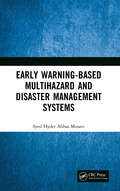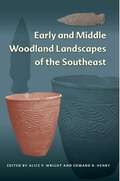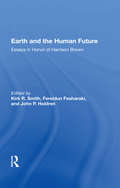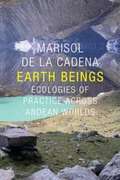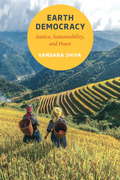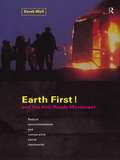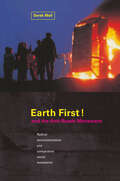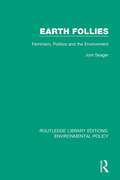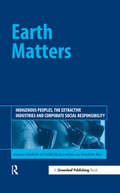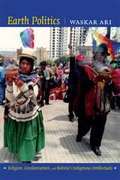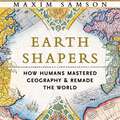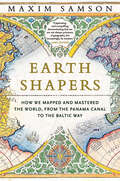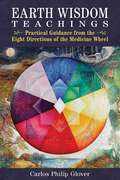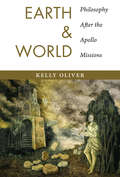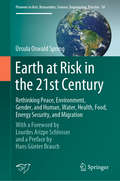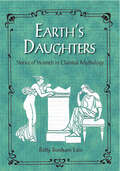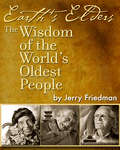- Table View
- List View
Early Warning Indicators of Corporate Failure: A Critical Review of Previous Research and Further Empirical Evidence (Routledge Revivals)
by Richard MorrisPublished in 1997, this text focuses on the conundrum between the academics ability to distinguish between failing and non-failing businesses with models of over 85.5per cent accuracy, and the reasons why credit agencies and the like do not act on such information. The author asks, are the models defective?
Early Warning-Based Multihazard and Disaster Management Systems
by Syed Hyder MusaviThis book describes in detail disaster management principles with applications through software and early warning systems. The aim is to introduce the concept of advanced technology for disaster management. Hence, it starts with a basic introduction and the types of disasters this technology will address. It then examines these functions by taking into account various factors vulnerable to disaster losses. Finally, the results are discussed with the aid of software: OPNET and SAHANA Disaster Management Tool. The application of sensor systems to manage a disaster is also extensively discussed. Features Introduces the concept of disaster management from the perspective of application of advanced technologies for disaster management Provides an overview of applied electronics for disaster applications Examines the role of efficient and robust Information and Communication Technology (ICT) systems for reduction of response time and for augmenting meaningful usage of resources during the disaster management phases of relief, response, recovery and rehabilitation
Early Women Psychoanalysts: History, Biography, and Contemporary Relevance (ISSN)
by Klara NaszkowskaEach life story is unique, yet each also entwines with other stories, sharing recurring themes linked to issues of gender, Jewishness, women's education, politics, and migration.The book's first section discusses relatively known analysts such as Sabina Spielrein, Lou Andreas-Salomé, and Beata Rank, remembered largely as someone's wife, lover, or muse; and the second part sheds light on women such as Margarethe Hilferding, Tatiana Rosenthal, and Erzsébet Farkas, who took strong political stances. In the third section, the biographies of lesser-known analysts like Ludwika Karpińska-Woyczyńska, Nic Waal, Barbara Low, and Vilma Kovács are discussed in the context of their importance for the early Freudian movement; and in the final section, the lives of Eugenia Sokolnicka, Sophie Morgenstern, Alberta Szalita, and Olga Wermer are examined in relation to migration and exile, trauma, loss, and memory.With a clear focus upon the continued importance of these women for psychoanalytic theory and practice, as well as discussion that engages with pertinent issues such as gendered discrimination, inhumane immigration laws, and antisemitism, this book is an important reading for students, scholars, and practitioners of psychoanalysis, as well as those involved in gender and women's studies, and Jewish and Holocaust studies.
Early and Middle Woodland Landscapes of the Southeast (Florida Museum of Natural History: Ripley P. Bullen Series)
by Alice P. Wright and Edward R. HenryFourteen in-depth case studies incorporate empirical data with theoretical concepts such as ritual, aggregation, and place-making, highlighting the variability and common themes in the relationships between people, landscapes, and the built environment that characterize this period of North American native life in the Southeast.
Early engagement and new technologies: Opening up the laboratory
by Ibo van de Poel Neelke Doorn Daan Schuurbiers Michael E. GormanDespite the topic's urgency and centrality, this is the first edited volume to offer a comprehensive assessment of the varying approaches to early engagement with new technologies, including nanotechnology, synthetic biology, biotechnology and ICT. Covering five main approaches to early engagement--constructive technology assessment (CTA), value-sensitive design (VSD), midstream modulation (MM), the network approach for moral evaluation, and political technology assessment--the book will be a pivotal text in the rapidly developing research field of ELSI, which explores the ethical, legal, and social implications of new technologies. Featuring leading scholars who discuss each early engagement approach in turn, the chapters cover both theory and applications, and include evaluative assessments of specific instances of early adoption of technologies. Further contributions focus on theoretical issues relevant to all approaches, including interdisciplinary cooperation, normativity and intervention, and political and public relevance. The publication has added profile due to the requirement of multi-billion-dollar research programs in the US and Europe to engage in ELSI research alongside that of the technical development itself, even in the early stages. Its comprehensive scrutiny of the core factors in early engagement will ensure a readership of policy makers as well as scientists and engineers.
Earth And The Human Future: Essays In Honor Of Harrison Brown
by Kirk R SmithDuring the second half of the twentieth century, great changes have occurred in the natural sciences, spawned by the leap forward in physics during the war years and the growth in understanding of earth's history and place in the cosmos. Also, with the new and terrible consequences of full-fledged war, the nuclear age has brought to the fore the ne
Earth Beings: Ecologies of Practice across Andean Worlds
by Robert J. Foster Marisol de la Cadena Daniel R. ReichmanEarth Beings is the fruit of Marisol de la Cadena's decade-long conversations with Mariano and Nazario Turpo, father and son, runakuna or Quechua people. Concerned with the mutual entanglements of indigenous and nonindigenous worlds, and the partial connections between them, de la Cadena presents how the Turpos' indigenous ways of knowing and being include and exceed modern and nonmodern practices. Her discussion of indigenous political strategies--a realm that need not abide by binary logics--reconfigures how to think about and question modern politics, while pushing her readers to think beyond "hybridity" and toward translation, communication that accepts incommensurability, and mutual difference as conditions for ethnography to work.
Earth Democracy
by Vandana ShivaWorld-renowned environmental activist and physicist Vandana Shiva calls for a radical shift in the values that govern democracies, condemning the role that unrestricted capitalism has played in the destruction of environments and livelihoods. She explores the issues she helped bring to international attention--genetic food engineering, culture theft, and natural resource privatization--uncovering their links to the rising tide of fundamentalism, violence against women, and planetary death. Struggles on the streets of Seattle and Cancun and in homes and farms across the world have yielded a set of principles based on inclusion, nonviolence, reclaiming the commons, and freely sharing the earth's resources. These ideals, which Dr. Shiva calls "Earth Democracy," serve as an urgent call to peace and as the basis for a just and sustainable future.From the Trade Paperback edition.
Earth First! and the Anti-Roads Movement: Radical Environmentalism And Comparative Social Movements
by Derek WallEarth First! is one of the most controversial and well known green movements in the world and the driving force behind the anti-road campaigns of the 1990s, made famous by sabotage tactics. Detailed accounts of major anti-road campaigns both in the UK and internationally are included, describing confrontations at Twyford, Newbury, Glasgow, the Autobahn in Germany, and information on the international spread of the Earth First! movement, with details of campaigns in Australia, Ireland, Germany, France, Holland and Eastern Europe. Earth First! and the Anti-Roads Movement traces the origins of the movement and the history of anti-roads activism in Britain since the 1880s. Radical EF! organisers describe how they took on their green activist identity, why they launched both EF! and the anti-roads movement, and their experiences of dramatic protest. Exposing the tensions between EF! and other green activists, they explain the political and economic influences on and the culture and politics of protest. Showing how green social and political theory can be linked to practical struggles for environmental and social change, Derek Wall investigates key topics of political and sociological interest in Britain and the World today. This is an authoritative account based on passionate and lyrical autobiographical accutns form activists blended with a strong theoretical grounding.
Earth First:Anti-Road Movement
by Derek WallFirst published in 1999. Routledge is an imprint of Taylor & Francis, an informa company.
Earth Follies: Feminism, Politics and the Environment (Routledge Library Editions: Environmental Policy #11)
by Joni SeagerFirst published in 1993. The question of ‘agency’ is essential to our understanding of environmental problems - who is responsible, and why? Threats such as ozone depletion, global warming and overconsumption are all precipitated by the powerful institutions which shape modern life – institutions which are overwhelmingly controlled by men and dominated by masculine presumptions. Joni Seager argues that the gender bias inherent in western culture is inextricably linked to our environmental crisis. She analyses the traditional institutes of power – governments, the military and transnational corporations - and also takes a critical look at the equally patriarchal environmental establishment, comparing the work of the official environmental movement, grounded in masculine thought, with the smaller-scale, direct actions taken by women driven to protect their homes and communities. Earth Follies represents an incisive and utterly convincing feminist critique of our environmental crises, and offers radical and productive priorities for the environmental agenda.
Earth Matters on Stage: Ecology and Environment in American Theater (Routledge Studies in Theatre, Ecology, and Performance)
by Theresa J. MayEarth Matters on Stage: Ecology and Environment in American Theater tells the story of how American theater has shaped popular understandings of the environment throughout the twentieth century as it argues for theater’s potential power in the age of climate change. Using cultural and environmental history, seven chapters interrogate key moments in American theater and American environmentalism over the course of the twentieth century in the United States. It focuses, in particular, on how drama has represented environmental injustice and how inequality has become part of the American environmental landscape. As the first book-length ecocritical study of American theater, Earth Matters examines both familiar dramas and lesser-known grassroots plays in an effort to show that theater can be a powerful force for social change from frontier drama of the late nineteenth century to the eco-theater movement. This book argues that theater has always and already been part of the history of environmental ideas and action in the United States. Earth Matters also maps the rise of an ecocritical thought and eco-theater practice – what the author calls ecodramaturgy – showing how theater has informed environmental perceptions and policies. Through key plays and productions, it identifies strategies for artists who want their work to contribute to cultural transformation in the face of climate change.
Earth Matters: Indigenous Peoples, the Extractive Industries and Corporate Social Responsibility
by Ciaran O'Faircheallaigh Saleem AliIndigenous peoples have historically gained little from large-scale resource development on their traditional lands, and have suffered from its negative impacts on their cultures, economies and societies. During recent decades indigenous groups and their allies have fought hard to change this situation: in some cases by opposing development entirely; in many others by seeking a fundamental change in the distribution of benefits and costs from resource exploitation. In doing so they have utilised a range of approaches, including efforts to win greater recognition of indigenous rights in international fora; pressure for passage of national and state or provincial legislation recognising indigenous land rights and protecting indigenous culture; litigation in national and international courts; and direct political action aimed at governments and developers, often in alliance with non-governmental organisations (NGOs). At the same time, and partly in response to these initiatives, many of the corporations that undertake large-scale resource exploitation have sought to address concerns regarding the impact of their activities on indigenous peoples by adopting what are generally referred to as "corporate social responsibility" (CSR) policies. This book focuses on such corporate initiatives. It does not treat them in isolation, recognising that their adoption and impact is contextual, and is related both to the wider social and political framework in which they occur and to the activities and initiatives of indigenous peoples. It does not treat them uncritically, recognising that they may in some cases consist of little more than exercises in public relations. However, neither does it approach them cynically, recognising the possibility that, even if CSR policies and activities reflect hard-headed business decisions, and indeed perhaps particularly if they do so, they can generate significant benefits for indigenous peoples if appropriate accountability mechanisms are in place. In undertaking an in-depth analysis of CSR and indigenous peoples in the extractive industries, the book seeks to answer the following questions. What is the nature and extent of CSR initiatives in the extractive industries and how should they be understood? What motivates companies to pursue CSR policies and activities? How do specific political, social and legal contexts shape corporate behaviour? What is the relationship between indigenous political action and CSR? How and to what extent can corporations be held accountable for their policies and actions? Can CSR help bring about a fundamental change in the distribution of benefits and costs from large-scale resource exploitation and, if so, under what conditions can this occur? Earth Matters gathers key experts from around the world who discuss corporate initiatives in Alaska, Ecuador, Australia, Canada, Peru, Papua New Guinea, Indonesia and Russia. The book explores the great diversity that characterises initiatives and policies under the name of "corporate social responsibility", the highly contingent and contextual nature of corporate responses to indigenous demands, and the complex and evolving nature of indigenous–corporate relations. It also reveals much about the conditions under which CSR can contribute to a redistribution of benefits and costs from large-scale resource development. Earth Matters will be essential reading for those working in and studying the extractive industry worldwide, as well as those readers looking for a state-of-the-art description of how CSR is functioning in perhaps its most difficult setting.
Earth Politics: Religion, Decolonization, and Bolivia’s Indigenous Intellectuals
by Waskar AriEarth Politics focuses on the lives of four indigenous activist-intellectuals in Bolivia, key leaders in the Alcaldes Mayores Particulares (AMP), a movement established to claim rights for indigenous education and reclaim indigenous lands from hacienda owners. The AMP leaders invented a discourse of decolonization, rooted in part in native religion, and used it to counter structures of internal colonialism, including the existing racial systems. Waskar Ari calls their social movement, practices, and discourse earth politics, both because the AMP emphasized the idea of the earth and the place of Indians on it, and because of the political meaning that the AMP gave to the worship of the Aymara gods. Depicting the social worlds and life work of the activists, Ari traverses Bolivia's political and social landscape from the 1920s into the early 1970s. He reveals the AMP 's extensive geographic reach, genuine grassroots quality, and vibrant regional diversity. Ari had access to the private archives of indigenous families, and he collected oral histories, speaking with men and women who knew the AMP leaders. The resulting examination of Bolivian indigenous activism is one of unparalleled nuance and depth.
Earth Power: Techniques of Natural Magic
by Scott CunninghamThis tried-and-true guide offers more than one hundred spells, rites, and simple rituals you can perform using the powerful energy of the earth.Here is magic that anyone can work with surprising results. It is the magic of nature—positive magic for positive solutions. When we look to the Earth, we discover answers that have been there all along.Within these pages you will find your own magician’s handbook. Your tools cost nothing and they are easy to obtain: the earth, fire, water, air…stones, trees, rain, and fog. Some of the tools, like mirrors, ropes, and candles, are linked with and tap into the power of nature by their symbolism. Each spell and divination is outlined in detail.When you practice any of the magic contained in this book, whether drawing a heart in the sand, gazing into a mirror for a glimpse of the future, or tying a knot to help a troubled friend, keep in mind the higher aspects of your workings. You are improving the world and helping to heal the ravages it has suffered. When we change ourselves, we change the world. It is this which makes the practitioner of natural magic truly divine.Includes more than 100 spells, rituals, and divinationsProvides the principles for performing effective magicInstills a sense of wonder concerning our planet and our livesPromotes a natural, positive practice that anyone can successfully perform
Earth Shapers: How Humans Mastered Geography and Remade the World
by Maxim SamsonMountains, meridians, rivers and borders; these are some of the features that carve up the world on our maps and in our minds. But geography is far less set in stone than we might believe and, over time, we have become experts at reshaping our surroundings.From the Qhapaq Ñan, South America's 'Great Road', and the Panama Canal to Mozambique's railways and Korea's sacred Baekdu-daegan mountain range, Samson explores how we mould the world around us. And how, as we etch our needs onto the natural landscape, we alter the course of history.An immense work of cultural geography touching on ecology, sociology, history and politics, Earth Shapers argues that, far from being constrained by geography, we are instead its creators.
Earth Shapers: How We Mapped and Mastered the World, from the Panama Canal to the Baltic Way
by Maxim SamsonThe globetrotting story of how humans have harnessed the geographical landscape and written ourselves onto our surroundings. Mountains, meridians, rivers, and borders—these are some of the features that divide the world on our maps and in our minds. But geography is far less set in stone than we might believe, and, as Maxim Samson’s Earth Shapers contends, in our relatively short time on this planet, humans have become experts at fundamentally reshaping our surroundings. From the Qhapaq Ñan, the Inca’s “great road,” and Mozambique’s colonial railways to a Saudi Arabian smart city, and from Korea’s sacred Baekdu-daegan mountain range and the Great Green Wall in Africa to the streets of Chicago, Samson explores how we mold the world around us. And how, as we etch our needs onto the natural landscape, we alter the course of history. These fascinating stories of connectivity show that in our desire to make geographical connections, humans have broken through boundaries of all kinds, conquered treacherous terrain, and carved up landscapes. We crave linkages, and though we do not always pay attention to the in-between, these pathways—these ways of “earth shaping,” in Samson’s words—are key to understanding our relationship with the planet we call home. An immense work of cultural geography touching on ecology, sociology, history, and politics, Earth Shapers argues that, far from being constrained by geography, we are instead its creators.
Earth Under Fire: Humanity's Survival of the Ice Age
by Paul A. LavioletteAnother book in a series of books on quantum physics exploring the construct of our universe. this book covers the coming galactic changes.
Earth Wisdom Teachings: Practical Guidance from the Eight Directions of the Medicine Wheel
by Carlos Philip Glover• Takes you through the eight directions of the Medicine Wheel to ignite your spirit fire, inspire deeper connection with all life on Earth, and open your creative, sensory, emotional, and intuitive intelligences• Shares practices such as deep listening, healing with the four elements, making death an ally, transforming limiting beliefs, discovering your animal teacher, and accessing inner wisdom• Explains how the transformation of consciousness influences those around you, allowing individual inner work to initiate collective change and ecological healingTHE FUTURE OF HUMANITY is in question, the world is in crisis and the Earth on fire. How can we find the inner strength to meet these challenges from a place of power?Aware that personal transformation serves the collective healing, Carlos Philip Glover takes you on a journey of self-empowerment around the Medicine Wheel of Earth Wisdom — to ignite your spirit fire, awaken new levels of consciousness, and inspire you to meet outer challenges through deep inner work. Each of the eight directions of the Medicine Wheel opens different aspects of your innate inner Earth Wisdom, including heartknowing and your creative, sensory, emotional, and intuitive intelligences. Experiential exercises and meditations allow you to grow and deepen your relationship with the Earth and all life on it. By accessing the wisdom of your body-mind and heart-knowing you can meet this time of great change with clarity and courage.Illustrated with heartful stories and inspiring images, Earth Wisdom Teachings is a practical guide for anyone who longs for a deeper relationship with Earth and Spirit and wants to contribute to the awakening of consciousness.
Earth and World
by Kelly OliverCritically engaging the work of Immanuel Kant, Hannah Arendt, Martin Heidegger, and Jacques Derrida together with her own observations on contemporary politics, environmental degradation, and the pursuit of a just and sustainable world, Kelly Oliver lays the groundwork for a politics and ethics that embraces otherness without exploiting difference. Rooted firmly in human beings' relationship to the planet and to each other, Oliver shows peace is possible only if we maintain our ties to earth and world.Oliver begins with Immanuel Kant and his vision of politics grounded on earth as a finite surface shared by humans. She then incorporates Hannah Arendt's belief in plural worlds constituted through human relationships; Martin Heidegger's warning that alienation from the Earth endangers not only politics but also the very essence of being human; and Jacques Derrida's meditations on the singular worlds individuals, human and otherwise, create and how they inform the reality we inhabit. Each of these theorists, Oliver argues, resists the easy idealism of world citizenship and globalism, yet they all think about the earth against the globe to advance a grounded ethics. They contribute to a philosophy that avoids globalization's totalizing and homogenizing impulses and instead help build a framework for living within and among the world's rich biodiversity.
Earth at Risk in the 21st Century: With a Foreword by Lourdes Arizpe Schlosser and a Preface by Hans Günter Brauch (Pioneers in Arts, Humanities, Science, Engineering, Practice #18)
by Úrsula Oswald SpringEarth at Risk in the 21st Century offers critical interdisciplinary reflections on peace, security, gender relations, migration and the environment, all of which are threatened by climate change, with women and children affected most. Deep-rooted gender discrimination is also a result of the destructive exploitation of natural resources and the pollution of soils, water, biota and air. In the Anthropocene, the management of human society and global resources has become unsustainable and has created multiple conflicts by increasing survival threats primarily for poor people in the Global South. Alternative approaches to peace and security, focusing from bottom-up on an engendered peace with sustainability, may help society and the environment to be managed in the highly fragile natural conditions of a ‘hothouse Earth’. Thus, the book explores systemic alternatives based on indigenous wisdom, gift economy and the economy of solidarity, in which an alternative cosmovision fosters mutual care between humankind and nature.• Special analysis of risks to the survival of humankind in the 21st century.• Interdisciplinary studies on peace, security, gender and environment related to global environmental and climate change.• Critical reflections on gender relations, peace, security, migration and the environment• Systematic analysis of food, water, health, energy security and its nexus.• Alternative proposals from the Global South with indigenous wisdom for saving Mother Earth.
Earth's Daughters: Stories of Women in Classical Mythology
by Betty LiesA "Who's Who" of women in classical mythology! The stories in this collection will not only satisfy the mythology lover and feminine scholar but make an outstanding curriculum supplement for humanities or literatures courses in elementary and high school. They are especially appropriate for courses emphasizing a returning emphasis on classical literature.
Earth's Elders
by Jerry FriedmanIn the creation of Earth's Elders, Jerry Friedman met, interviewed and photographed some of the world's oldest elders - 110 years old or older (supercentenarians, as researchers call them).Jerry Friedman, photographer, author and founder of Earth's Elders, spent four years on a landmark project to introduce the world to the sixty oldest people on earth. Using his lens to capture a community that has never before been documented, the award-winning photographer has shed new light on the "invisible" world of people 110 years and older.With each visit on his globetrotting journey to capture the lives of these "super centenarians," Friedman gained a deeper understanding of what the elderly in every culture have to offer. Inspired by the opportunity to improve the quality of life of the elderly, to teach children to recognize the wisdom and value of the elderly as essential parts of our society, and to improve the health of our communities through intergenerational tolerance and communication, Friedman created Earth's Elders.
Earth, Cosmos and Culture: Geographies of Outer Space in Britain, 1900–2020 (Routledge Research in Historical Geography)
by Oliver Tristan DunnettThis book traces the development of diverse British cultures of outer space, utilizing key geographical concepts such as landscape, place, and national identity. It examines the early visionary ideas of writers H. G. Wells and Olaf Stapledon, the ambitious British space programme of the 1960s, and narrations of British cultural identity that accompanied the space missions of Helen Sharman, Beagle 2 and Tim Peake. The exploration of British cultures of outer space throughout the book helps understand the emergence of the British Interplanetary Society. It also explains its significance in pre-war and post-war periods through an analysis of the roles of influential figures such as Arthur C. Clarke and Patrick Moore. The chapters explore utopian and dystopian representations of space exploration, examine the mysterious phenomenon of UFO culture, and consider plans for humanity’s imagined future across interstellar space. Throughout the book geography is advocated as a home for critical studies of outer space, illuminating its significance in terms of the reciprocal relationships between exploration and the sublime, science and the imagination, Earth and cosmos. As an emergent field of research in the social sciences, this book makes an excellent contribution to the study of the outer space in Britain and abroad developing a distinctive kind of outer spatial geography with major implications for future teaching and research.
Earth, Water, Fleece and Fabric: An Ethnography and Archaeology of Andean Camelid Herding
by Penny DransartThrough a richly detailed examination of the practices of spinning yarn from the fleece of llamas and alpacas, Earth, Water, Fleece and Fabric explores the relationship that herders of the present and of the past have maintained with their herd animals in the Andes. Dransart juxtaposes an ethnography of an Aymara herding community, based on more than ten years fieldwork in Isluga in the Chilean highlands, with archaeological material from excavations in the Atacama desert.Impeccably researched, this book is the first systematic study to set the material culture of pastoral communities against an understanding of the long-term effects of herding practices.

